A Goddess, By Any Other Name…
“What say I then? that the idol is any thing, or that which is offered in sacrifice to idols is any thing? But I say that the things which the Gentiles sacrifice, they sacrifice to devils, and not to God.”
1 Corinthians 10:19-20
Grace and peace to the children of light, and greetings to the children of darkness.
This morning, I followed a link on a particular website discussing the biblical Diana of Ephesus. Unbeknownst to me, the link was to a website called The Catholic Word of the Day, which gave a definition of Diana from the Modern Catholic Dictionary. I was instantly surprised; for you see, this dictionary’s definition of Diana of Ephesus marvelously proves my contention that the idol whom Roman Catholics call the Virgin Mary, is not the mother of Jesus, but the goddess Semiramis, who, since antiquity, has gone by many names.
For those of you who may not be familiar with Diana of Ephesus, let us turn to Chapter 19 of the Book of Acts, which gives a brief discussion of her. To set this up for you, the Apostle Paul is in Ephesus preaching the Gospel and against idolatry. This prompts certain of the townspeople who have made a lucrative living from the industry of idolatry to hold a meeting to decide what they will do about Paul. We pick up at this point:
“For a certain man named Demetrius, a silversmith, which made silver shrines for Diana, brought no small gain unto the craftsman; Whom he called together with the workmen of like occupation, and said, Sirs, ye know that by this craft we have our wealth. Moreover ye see and hear, that not alone at Ephesus, but almost throughout all Asia, this Paul hath persuaded and turned away much people, saying that they be no gods, which are made with hands: So that not only this our craft is in danger to be set at naught; but also that the temple of the great goddess Diana should be despised, and her magnificence should be destroyed, whom all Asia and the world worshippeth. And when they heard these sayings, they were full of wrath, and cried out, saying, Great is Diana of the Ephesians.”
Acts 19:24-28
As one can plainly see, the biblical Diana of Ephesus was (and is) an idol, which was worshipped in “all Asia and the world.” Now, if Diana of Ephesus was worshipped all over the world, it is logical to assume that she was worshipped under different names depending on the language of the country where she was worshipped. Understand that unlike today, people were not just given names arbitrarily. A name meant something, and people were named for a variety of reasons, including personal qualities, skin color, physical attributes, and even significant events. The tenth chapter of the book of Genesis, for example, gives an excellent example of the latter:
“And Arphaxad begat Salah; and Salah begat Eber. And unto Eber were born two sons: the name of one was Peleg; for in his days was the earth divided; and his brother’s name was Joktan.”
Genesis 10:24-25
The son of Eber was named Peleg because “in his days the earth was divided.” Now, the Bible mentions only one such global division, and that can be found in Genesis 11:9, where we are told that after God confused the people’s speech at the Tower of Babel, the Lord “scattered them abroad upon the face of all the earth.” The name Peleg literally means “division.” For the first time in history, the world was divided: not only geographically, but culturally and linguistically. Peleg was named for this monumental event.
An example of someone named based on a personal attribute would be Nabal, the husband of Abigail, who later became one of King David’s wives. Nabal means, “foolish,” and Abigail even went so far as to say that Nabal’s name matched his personality (1 Samuel 25:25). And an example of someone named after his skin color was Esau, who was named Edom, because he was “red.” Edom means red. There are many biblical examples of people whom God Himself renamed or surnamed, including Abram, whom God renamed Abraham; Saul of Tarsus, whom Jesus renamed Paul (the Apostle to the Gentiles); and the Apostle Simon, whom Jesus surnamed Peter or Cephas, which means “a stone.”
So, it was not at all unusual for a person to be known by different names, all having different meanings. Now, if this was true for people, it certainly must have also been true for gods and goddesses, as they were, and are, merely different manifestations of the same two people: Nimrod and Semiramis. The different names are merely based on their many qualities and attributes–whether real or invented–and are determined by the attribute and the language.
Athena, for example, is the Greek goddess of wisdom, but she is known to the Romans as Minerva. She is also called Sophia, the Greek word for wisdom: same attribute, but different languages and, hence, different names. Keep this in mind as we continue our discussion of Diana of Ephesus, for she is, in fact, Athena, Minerva, and Sophia, and also goes by many other names, including Mary.
Now, according to the Catholic Word of the Day, the Modern Catholic Dictionary gives this definition of Diana of Ephesus:
“Roman goddess of the moon, identified with Artemis among the Greeks who worshiped her as a virgin huntress. The Diana of the Ephesians was a combination of Artemis and the Semitic goddess Ashtoreth, patroness of the sexual instinct…”
The first sentence alone contains ample information to prove my contention that Diana of Ephesus is merely another name for the goddess whom Roman Catholics worship as the Virgin Mary. First, note that Diana is said to be a Roman goddess, yet she is identified with the Greek goddess, Artemis. “Identified with” is merely a clever way to say “also called,” for you see, those who know the true identity of the goddess they worship don’t want the general population or the less informed devotees to know that all the different goddesses are the same person. Moreover, is it merely a coincidence that both the goddess Diana and the Roman Catholic Mary are Roman? I submit that it is not.
Next, the Modern Catholic Dictionary says that Diana was the Roman goddess of the moon. It is interesting to note that the Virgin Mary is also identified with the moon as the following images demonstrate:
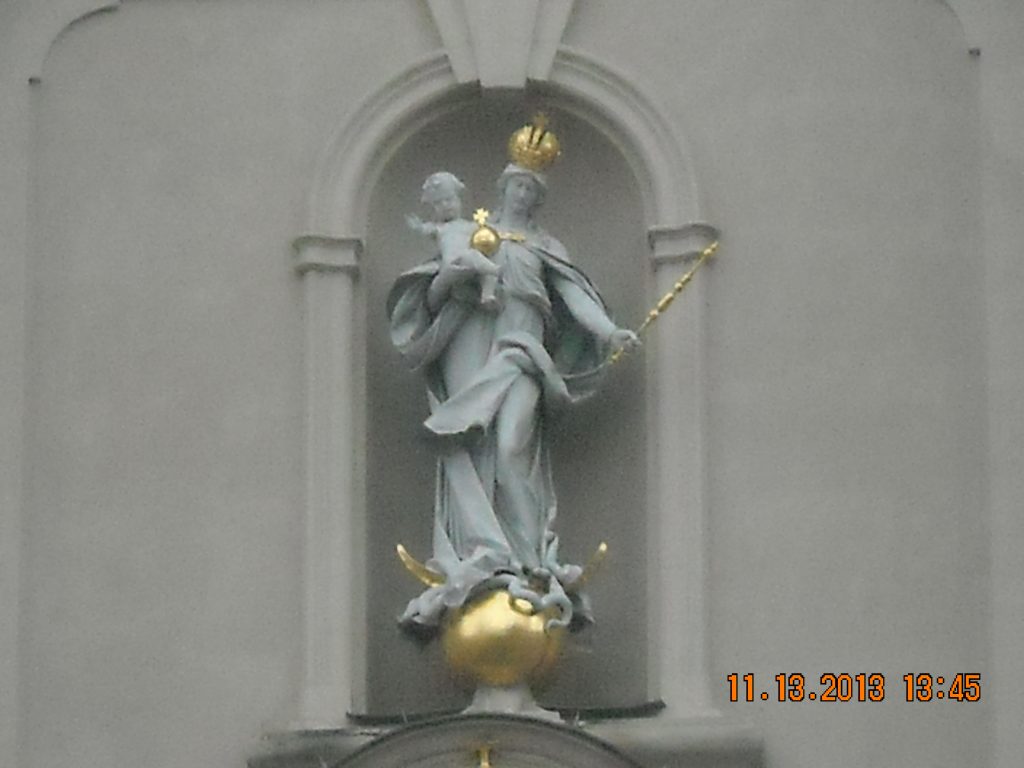
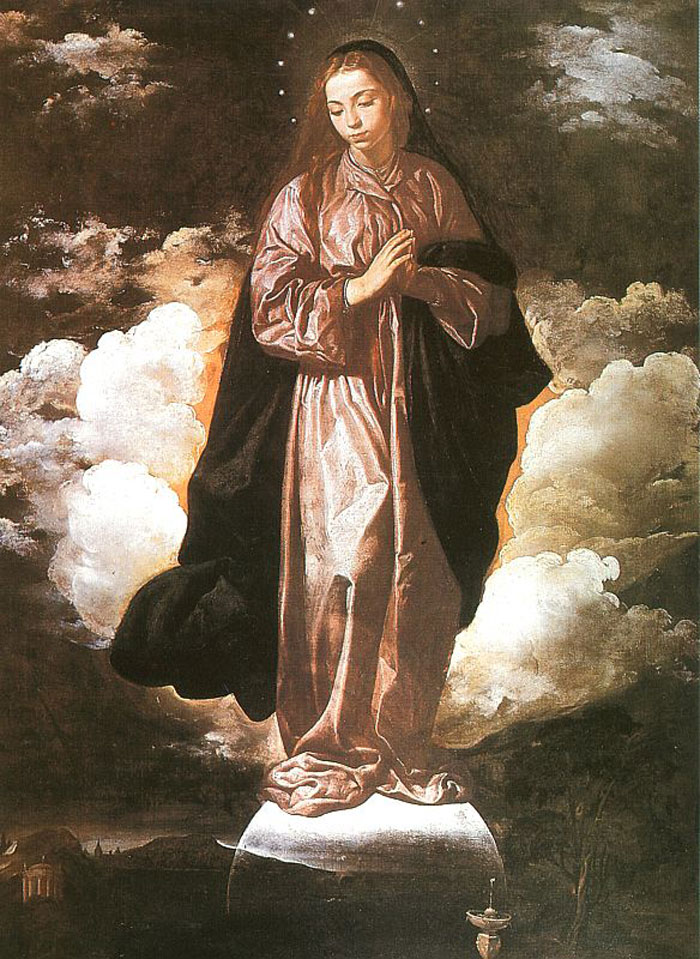
The above photo is very telling as the artist includes, in left bottom background, a replica of the Temple of Diana, further identifying the Virgin Mary with Diana. It should be noted that the Egyptian goddess, Isis, was also known as the goddess of the moon. Could this be another coincidence?
The Modern Catholic Dictionary says that the Greeks worshipped Artemis as a virgin, though it doesn’t say that Diana was worshipped as such. Alexander Hislop, however, in The Two Babylons, says that Diana was also worshipped as a virgin (p. 30). And everyone knows that the Roman Catholic Mary is called The Virgin. All three goddesses share this significant trait. Yet another coincidence?
A goddess by any other name…
This next series of photos concerns a manifestation of the Virgin Mary in Mexico called “Our Lady of Guadalupe.”
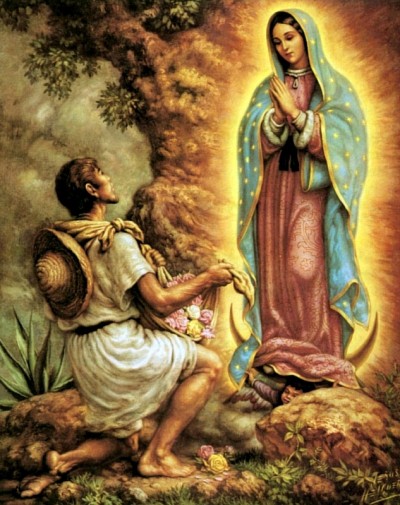
The reader will notice that, again, the Virgin is standing on a crescent moon, which, again, identifies her as Diana, the moon goddess. By the way, the Guadalupe manifestation of the goddess tells us much about the Roman Catholic exaltation of the Virgin Mary, and proves that though Roman Catholics claim to love Jesus Christ, they actually exalt Mary above Him.
The name Guadalupe is very interesting indeed. The Catholic Word of the Day’s featured term for August 22, 2009 was “Luminous Rays,” and a reader posted a response, which included a picture of “Our Lady of Guadalupe” and featured the following prayer:
“Dearest Lady of Guadalupe, fruitful Mother of Holiness, teach me your ways of gentleness and strength. Hear my prayer, offered with deep-felt confidence to beg this favor…
“O Mary, conceived without sin, I come to your throne of grace to share the fervent devotion of your faithful Mexican children who call to thee under the glorious Aztec title of “Guadalupe”–the Virgin who crushed the serpent.
“Queen of Martyrs, whose Immaculate Heart was pierced by seven swords of grief, help me to walk valiantly amid the sharp thorns strewn across my pathway.
“Invoke the Holy Spirit of Wisdom to fortify my will to frequent the Sacraments so that, thus enlightened and strengthened, I may prefer God to all creatures and shun every occasion of sin.
“Help me, as a living branch of the vine that is Jesus Christ, to exemplify His Divine charity always seeking the good of others. Queen of Apostles, aid me to win souls for the Sacred Heart of my Savior.
“Keep my apostolate fearless, dynamic and articulate, to proclaim the loving solicitude of Our Father in Heaven so that the wayward may heed His pleading and obtain pardon, through the merits of your merciful Son, Our Lord Jesus Christ. Amen.”
What an incredibly revealing prayer! Understand that Roman Catholics claim to pray to Mary as an intermediary between them and “Jesus.” They believe that Jesus sits on His throne a stern, angry, judgmental God, ready to destroy mankind at any moment for our sinfulness and disobedience. They therefore petition Mary, who they believe intercedes on their behalf, because Jesus “cannot deny His mother.” But, as one can plainly see, Mary is not the intermediary here. These petitions are to Mary herself.
But notice that, according to the prayer, the name Guadalupe means, “The Virgin who crushed the serpent.” This is an obvious reference to Genesis 3:15. After Adam and Eve ate the forbidden fruit, God cursed the serpent and made the following decree:
“I will put enmity between thee and the woman, and between thy seed and her seed; it shall bruise thy (the serpent’s) head, and thou (the serpent) shalt bruise his (Jesus’) heel.”
Genesis 3:16
The serpent, of course, is the devil. The identity of the seed, however, is interesting, because God does not say “He shall bruise thy head” which would imply that the seed is Jesus Christ. Instead, the third person singular neuter pronoun “it” is used. Now, “it” could refer to the “seed,” but it could also refer to something else.
There is only one other reference I know of to Satan’s head being bruised, and it can be found in Romans Chapter 16:
“And the God of peace shall bruise Satan under your feet shortly.”
Romans 16:20
The God of peace, of course, is Jesus Christ (2 Corinthians 13:11). So, it is Jesus who shall bruise the serpent’s head, and He will do it through the Christian Church. Roman Catholics, however, believe that it is Mary who will bruise the serpent’s head. They believe that “the woman” spoken of in Genesis 3:15 is Mary, and “the seed” is Jesus Christ. But the Bible teaches that the woman is Israel (Revelation 12:1-17). The enmity between Satan and the woman, therefore, is the enmity between Satan and the Jews.
As for the seed, think about this for a minute: Satan is a spirit, so he cannot have seed: that is, children. God is not only talking about physical seed, then, but also spiritual seed. Israel, the woman, has two types of seed: physical seed (the Jews), and spiritual seed (the Christian church):
“Now to Abraham and his seed were the promises made. He saith not, And to seeds, as of many; but as of one, And to thy seed, which is Christ...And if ye be in Christ, then are you Abraham’s seed, and heirs according to the promise.”
Galatians 3:16,29
This is why Paul said that Jesus would bruise Satan’s head under the Church’s feet. It is Christ Jesus, through the Church, that will crush Satan’s head, not the Virgin Mary. If God had meant that Mary would crush the serpent’s head, He would have said, “She shall bruise thy head.” But He didn’t say that.
The most troubling element of this prayer is that the petitioner desires to approach Mary’s “throne of grace.” Nowhere in the Bible is Mary declared a queen, and nowhere in the Bible is Mary said to have a throne. This is Catholic tradition, not biblical doctrine. Moreover, not only is Mary declared to have a throne, but it is a “throne of grace.” According to the Bible, only one person has a throne of grace: the Lord Jesus Christ:
“Seeing then that we have a great High Priest, that is passed on into the heavens, Jesus the Son of God, let us hold fast our profession. For we have not an High Priest which cannot be touched with the feeling of our infirmities; but was in all points tempted as we are, yet without sin. Let us therefore come boldly unto the throne of grace, that we may obtain mercy, and find grace to help in time of need” (Hebrews 4:14-16).
Hebrews 4:14-15
As stated, the Roman Catholic church exalts Mary into the place of our Savior, the Lord Jesus. This can again be proven by the fact that this prayer declares that Mary was “conceived without sin.” This is the blasphemous doctrine of the Immaculate Conception: a doctrine that does not come from the Authorized Version of the Bible, the King James, but was actually decided by a Vatican council and can be found in one of the Apocryphal books:
“Thou art all fair, O Mary, and there is in thee no stain of original sin.”
Judith 13
The Apocrypha was never accepted as Holy Writ, as it was not part of the Masoretic or Received Text, but was part of the corrupted texts that came from the Gnostic schools of Alexandria, Egypt. The Holy Bible teaches that Mary, after giving birth to our Savior, went to Jerusalem and offered a sin sacrifice (Luke 2:24).
The only person born without sin was Jesus Christ (Hebrews 4:15, 1 John 3:5, 2 Corinthians 5:21).
And think about this for a minute: If Mary was “conceived without sin,” then why wasn’t she worthy to die for the sins of mankind? Hmmm? For the answer to this question, and more, about the Virgin Mary, we strongly suggest that you read the article, Two Marys. It will open your eyes.
If the reader still doubts that Roman Catholicism exalts Mary above Jesus, I invite him to examine the following photos of “Our Lady of Guadalupe”:

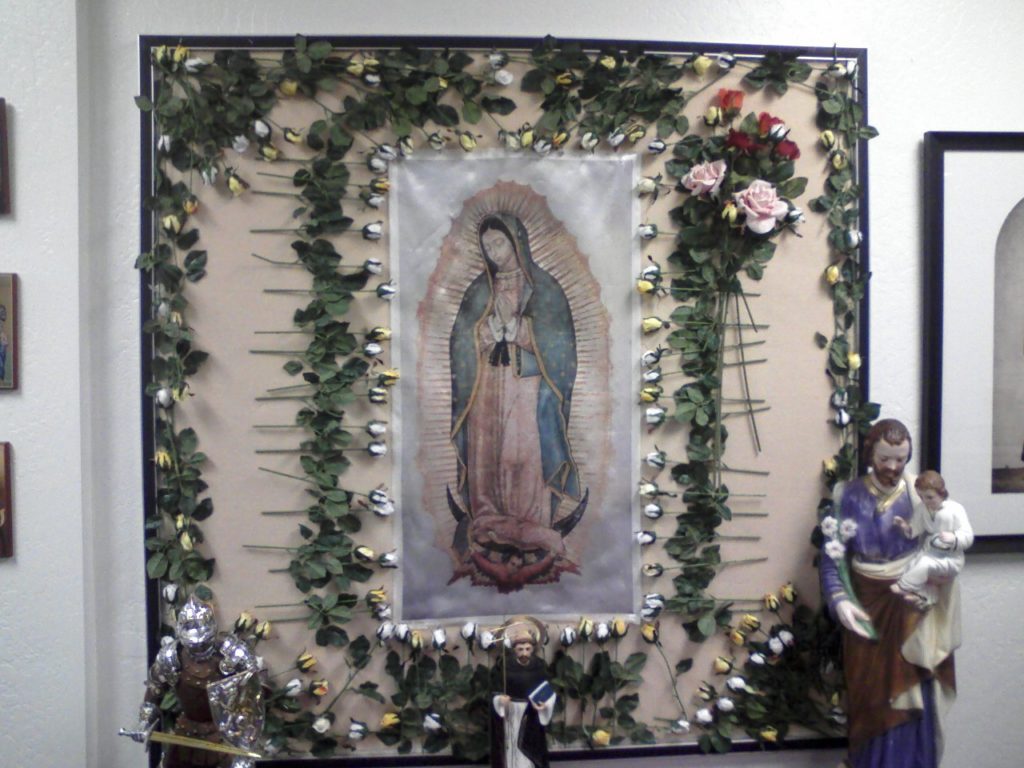
Please direct your attention to the angel at the bottom of the photos. Notice his hands. Can you see that they are grabbing the hem of Mary’s dress and cloak? Now prayerfully read the following biblical Gospel account:
“While [Jesus] spake these things unto them, behold, there came a certain ruler, and worshipped Him, saying, My daughter is even now dead: but come and lay thy hand upon her, and she shall live. And Jesus arose, and followed him, and so did His disciples.
And, behold, a woman, which was diseased with an issue of blood twelve years, came behind Him, and touched the hem of His garment: For she said within herself, If I may but touch His garment, I shall be whole. But Jesus turned Him about, and when He saw her, He said, Daughter, be of good comfort; thy faith hath made thee whole. And the woman was made whole from that hour.”
Matthew 9:18-21
Did you get that? The woman touched the hem of Jesus’ garment and was made whole.
Now someone reading this will believe that the placement of the angel’s hands was purely coincidental. But what they do not understand is that in the world of the occult (and make no mistake, the Roman Catholic church is an occult organization) nothing is coincidental. Everything in the occult, even down to the minutest detail in a painting, is done deliberately and intentionally. The Roman Catholic church is appropriating the qualities of Jesus, including His mercy, grace, power to heal, and, yes, even His divinity, and attributing them to the Virgin Mary. Make no mistake about that.
The message of these paintings of “Our Lady of Guadalupe” is that Mary can make you whole. And listen to this very carefully: if Mary can make you whole, then Mary can save you. And that is what the Roman Catholic church really believes and teaches, but will not outright say. They are calling Mary the Saviour.
If you have a problem digesting this, consider that only God is sinless, as the Bible clearly teaches that since Adam’s fall, all mankind is sinful (Romans 5:12). Only Jesus was sinless, and Jesus Christ is God Almighty (Revelation 1:8). For Mary to be sinless, as the Roman Catholic church teaches, she would have to be God. And they know this. The Roman Catholic church is calling Mary a goddess, because they know full well that she is, in fact, the goddess Semiramis, who, by the way, was also called Myrianimous: the goddess of many names. Mary is Semiramis.
If you cannot get your head around this, check out this video below of Pope Francis, speaking in code, calling the Virgin Mary Semiramis.
Now, read this article, so you can understand the pope’s cryptic remarks. Now, please ponder these revelations.
Returning to our comparison of Diana and the Virgin Mary, there is one last thing that I want you to consider very, very carefully. But first, let us take one final look at the Modern Catholic Dictionary’s definition of Diana of Ephesus:
“Roman goddess of the moon, identified with Artemis among the Greeks who worshiped her as a virgin huntress. The Diana of the Ephesians was a combination of Artemis and the Semitic goddess Ashtoreth, patroness of the sexual instinct…”
Note that Diana was not only identified with Artemis, but she was also identified with Ashtoreth, patroness of the sexual instinct. This aspect of sexuality identifies Diana with Aphrodite, the Greek goddess of sexual love.
Now, I want you to consider something. Did you ever notice that almost every image of the Virgin Mary shows her standing with one knee bent? Almost without exception, she is shown in this position. Have you ever wondered why the Virgin Mary stands in this curious position? I had, and it always puzzled me. I knew it had to have a meaning, but for the life of me, I couldn’t understand what.
Then the Spirit showed me. Did you ever consider that in this position, Mary’s legs are actually slightly apart or, if you will, slightly open? If you think about it, this is not a very flattering position for a woman, especially a purported virgin. In the old days, paintings, drawings, and photos of women of good report always depicted them with their legs closed to symbolize their chastity. But Mary’s legs are not closed.
If we consider that nothing–absolutely nothing–in the world of the occult is coincidental, then we must consider that this has been done intentionally and for a very specific purpose. I submit that it has been done to identify the Virgin Mary with Aphrodite, the goddess of sexual love. And if Mary is Aphrodite, then she is also Diana, Artemis, Cebele, Demeter, Ceres, Ashtoreth, and a host of other goddesses, because, somewhere along the line, they all share a common attribute, and that attribute always has something to do with sex: either sexual promiscuity as in the case of Aphrodite and Ashtoreth, or, in the case of Artemis and the Virgin Mary, sexual abstinence.
Tradition has it that Semiramis, the wife of Nimrod, who was deified and worshipped, was a very promiscuous and sexually immoral woman. Incidentally, though the Ephesian Diana was said to have been a virgin, the Roman Diana was also the goddess of sexual love.
To further prove this point, I submit to you one more piece of information. According to historian, Alexander Hislop, in his book, The Two Babylons, Semiramis was also known as Columbia, The Dove. That is why so many things in not just America, but the world, are called Columbia or a derivative of that name. Now, with this in mind, examine this photo of the “icon” of Columbia Pictures:

Notice that “The Lady” pictured is standing exactly how the Virgin Mary is almost always depicted. And notice how the nice, moral people at Columbia Pictures were kind enough to “illuminate” her leg so we can get a good look! And they were so intent on doing this that they defied the laws of light, for the torch that Columbia (or Liberty) is holding is so bright that there is no way her leg could be backlit in this manner. They are telling us that this is Aphrodite, the goddess of love.
By the way, notice the pyramid-shaped cloud behind Columbia. Now notice that there are actually three such clouds, side-by-side, though the other two are not shown in their entirety. I’ve seen many clouds in my day, but I’ve never seen one shaped quite like a pyramid. And I’ve definately never seen three in a row. Notice also that the three quasi pyramid shaped clouds are somewhat staggered: the left is slightly behind the center, which is slightly behind the right. Now, where have we seen something like that?

Uh-huh. These clouds are symbols for the Egyptian pyramids at Giza. And if you think I’m reaching for straws, notice that the center pyramid, called the Great Pyramid of Chiops, has a capstone. Now notice that the light from Columbia’s torch is placed exactly where the capstone of the Great Pyramid would be. Now take a look at this:
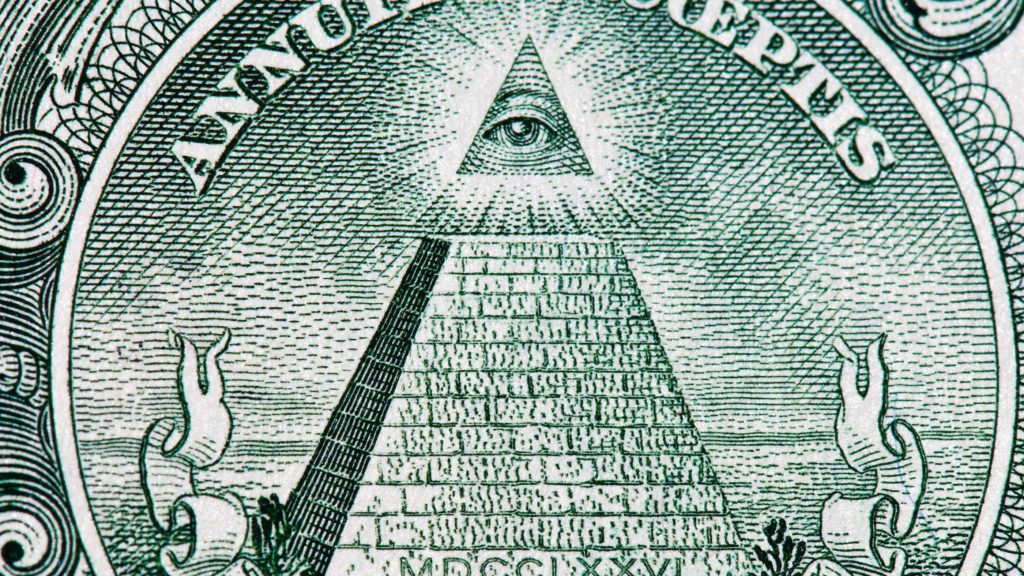
Saints, this is no coincidence. This pyramid symbolism suggests that Columbia is also Isis, the Egyptian goddess of the moon and of sexual love.
The placement of the torch also suggests that the torch is a symbol for the Egyptian God, Horus, who is really the great rebel, Nimrod. But that’s another story.
Further proof that Mary is Aphrodite can be found in the prayer to “Our Lady of Guadalupe,” where, in the first line, Mary is called “fruitful.” With respect to women, this word has always been used to mean bountiful in childbirth. Recall that in the second chapter of Genesis, God tells Adam and Eve to “be fruitful and multiply.” Now let me ask you a question: can a virgin be fruitful?
Now you may ask how the goddess came to be known as Mary. Well, perhaps you have seen images of a naked goddess standing in a sea shell:
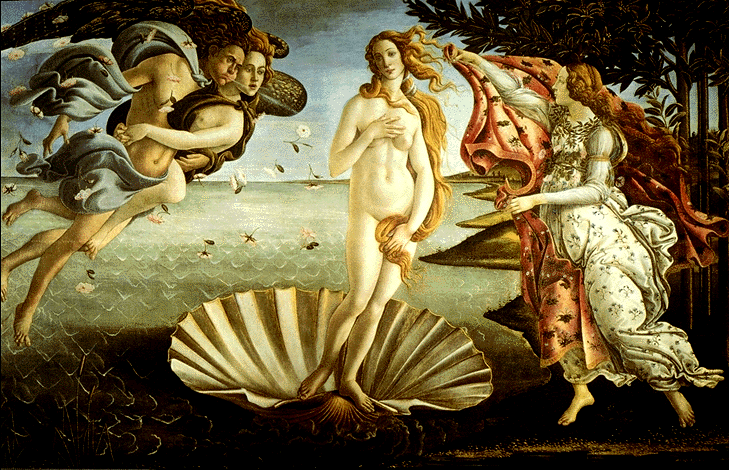
That goddess is Venus, the goddess of the sea. Later, the sea came to be known as The Mare (latin: mari or mare), and so, the goddess became known as Mary. Find this unbelievable? Well, notice that Venus is standing in a sea shell. Now consider the following photo:
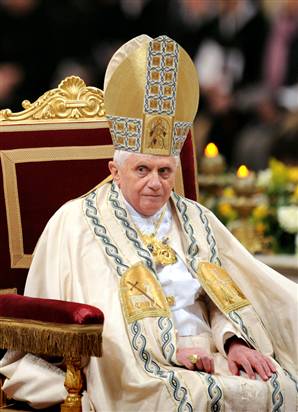
Notice the sea shell and stylized waves of the sea on the back of the pope’s chair? Now consider this photo:
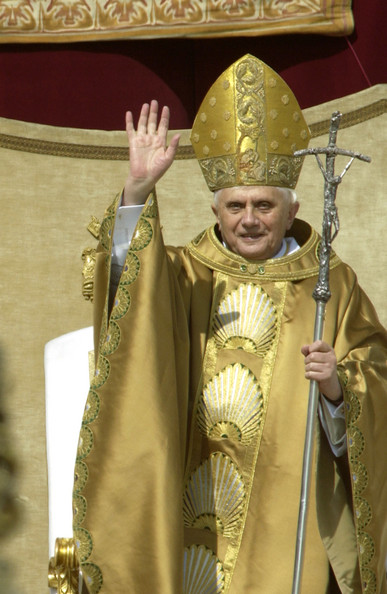
And this:
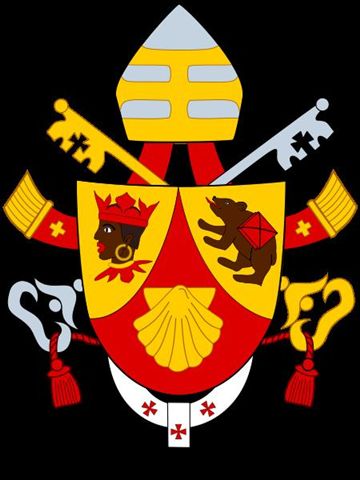
The Virgin Mary is not only called Aphrodite, but also Ashtoreth, the same goddess that King Solomon and the apostate Jews worshipped and symbolized with a star. Read more about it here, and here. Those who worship the goddess use secret hand signs to identify themselves to one another. Read more about the Cult of Mary here.
The podcast of this teaching is available at the iTunes Store for playback on your favorite audio device. You can subscribe to our podcast for free here.
Think.
The Still Man
P.S. The idol Mary is called the Abomination of Desolation in the Bible. In the New World Order kingdom of Antichrist, the world will be required to worship this goddess or perish. You may want to read more about it here.
Be encouraged and look up, for your redemption draweth nigh.
The Still Man
Podcast: Play in new window | Download
Subscribe: RSS
